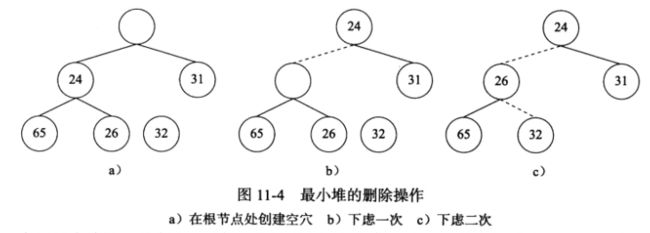Linux高性能服务器编程 学习笔记 第十一章 定时器
网络程序需要处理定时事件,如定期检测一个客户连接的活动状态。服务器进程通常管理着众多定时事件,有效地组织这些定时事件,使其在预期的时间被触发且不影响服务器的主要逻辑,对于服务器的性能有至关重要的影响。为此,我们要将每个定时事件分别封装成定时器,并使用某种容器类数据结构,如链表、排序链表、时间轮,将所有定时器串联起来,以实现对定时事件的统一管理。本章讨论两种高效的管理定时器的容器:时间轮和时间堆。
定时指一段时间后触发某段代码的机制,我们可以在这段代码中依次处理所有到期的定时器,即定时机制是定时器得以被处理的原动力。Linux提供三种定时方法:
1.socket套接字选项SO_RCVTIMEO和SO_SNDTIMEO。
2.SIGALRM信号。
3.IO复用系统调用的超时参数。
SO_RCVTIMEO和SO_SNDTIMEO分别用来设置socket接收和发送数据的超时时间。作者接下来在书里说,这两个socket选项只对socket专用的数据接收和发送系统调用有效,作者给出的专用系统调用为send、sendmsg、recv、recvmsg、accept、connect,但Linux的man page中显示它们适用于所有执行套接字IO操作的系统调用:


由上表,我们可以根据系统调用的返回值和errno来判断超时时间是否已到,进而决定是否开始处理定时任务,下面以connect函数为例,说明SO_SNDTIMEO套接字选项如何来定时:
#include 由alarm和setitimer(可设置周期性触发的定时器)函数设置的闹钟一旦超时,将触发SIGALRM信号,我们可利用该信号的信号处理函数来处理定时任务,但如果要处理多个定时任务,我们就需要不断触发SIGALRM信号。一般,SIGALRM信号按固定的频率生成,即由alarm或setitimer函数设置的定时周期T保持不变,如果某个定时任务的超时时间不是T的整数倍,那么它实际被执行的时间和预期的时间将略有偏差,因此定时周期T反映了定时的精度。
定时器通常至少要包含两个成员:一个超时时间(相对时间或绝对时间)和一个任务回调函数。有时还可能包含回调函数被执行时需要传入的参数,以及是否重启定时器等信息。如果使用链表作为容器来串联所有定时器,则每个定时器还要包含指向下一定时器的指针成员,如果链表是双向的,则每个定时器还需要包含指向前一个定时器的指针成员。
以下代码实现了简单的升序定时器链表,其中的定时器按超时时间做升序排序:
#ifndef LST_TIMER
#define LST_TIMER
#include sort_timer_lst类是一个升序链表,其核心函数tick相当于心博函数,它每隔一段固定的时间执行一次,以检测并处理到期的任务。判断定时任务到期的依据是定时器的expire值小于当前的系统时间,以检测并处理到期的任务。从执行效率来看,如果链表中有n个定时器,则添加定时器的时间复杂度是O(n),删除定时器的时间复杂度是O(1),执行定时任务的时间复杂度平均是O(1)。
现在考虑以上升序定时器链表的实际应用,处理非活动连接。服务器进程通常要定期处理非活动连接,可这样处理非活动的连接:给客户端发一个重连请求,或关闭该连接,或者其他。Linux在内核中提供了对连接是否处于活动状态的定期检查机制,我们可通过socket选项KEEPALIVE来激活它。我们在应用层实现类似KEEPALIVE的机制,以管理所有长时间处于非活动状态的连接,如以下代码利用alarm函数周期性地触发SIGALRM信号,该信号的信号处理函数利用管道通知主循环执行定时器链表上的定时任务——关闭非活动的连接:
#include Linux下的3组IO复用系统调用都带有超时参数,因此它们不仅能统一处理信号(通过管道在信号处理函数中通知主进程)和IO事件,也能统一处理定时事件,但由于IO复用系统调用可能在超时时间到期前就返回(有IO事件发生),所以如果我们要利用它们来定时,就需要不断更新定时参数以反映剩余的时间,如下代码所示:
#define TIMEOUT 5000
int timeout = TIMEOUT;
time_t start = time(NULL);
time_t end = time(NULL);
while (1) {
printf("the timeout is now %d mil-seconds\n", timeout);
start = time(NULL);
int number = epoll_wait(epollfd, events, MAX_EVENT_NUMBER, timeout);
if ((number < 0) && (errno != EINTR)) {
printf("epoll failure\n");
break;
}
// 如果epoll_wait函数返回0,说明超时时间到,此时可处理定时任务,并重置定时时间
if (number == 0) {
// 处理定时任务
timeout = TIMEOUT;
continue;
}
// 到此,epoll_wait函数的返回值大于0,
end = time(NULL);
// 更新timeout的值为减去本次epoll_wait调用的持续时间
timeout -= (end - start) * 1000;
// 重新计算后的timeout值可能是0,说明本次epoll_wait调用返回时,不仅有文件描述符就绪,且其超时时间也刚好到达
// 此时我们要处理定时任务,并充值定时时间
if (timeout <= 0) {
// 处理定时任务
timeout = TIMEOUT;
}
// handle connections
}
基于排序链表的定时器存在一个问题:添加定时器的效率偏低。下面讨论的时间轮解决了这个问题,一种简单的时间轮如下图:

上图中,时间轮内部的实线指针指向轮子上的一个槽(slot),它以恒定的速度顺时针转动,每转动一步就指向下一个槽(虚线指针所指的槽),每次转动称为一个滴答(tick),一个滴答的时间称为时间轮的槽间隔si(slot interval),它实际上就是心博时间。上图中的时间轮共有N个槽,因此它转动一周的时间是Nsi。每个槽指向一条定时器链表,每条链表上的定时器具有相同的特征:它们的定时事件相差Nsi的整数倍,时间轮正是利用这个关系将定时器散列到不同的链表中。假如现在指针指向槽cs,我们要添加一个定时事件为ti的定时器,则该定时器将被插入槽ts(timer slot)对应的链表中:
![]()
基于排序链表的定时器使用唯一的一条链表来管理所有定时器,所以插入操作的效率随着定时器数目的增多而降低,而时间轮使用哈希表的思想,将定时器散列到不同的链表上,这样每条链表上的定时器数目都将明显少于原来的排序链表上的定时器数目,插入操作的效率基本不受定时器数目的影响。
对时间轮而言,要想提高定时精度,就要使si足够小,要提高执行效率,就要求N足够大(N越大,散列冲突的概率就越小)。
以下代码描述了一种简单的时间轮,因为它只有一个轮子,而复杂的时间轮可能有多个轮子,不同的轮子有不同的粒度,相邻的两个轮子,精度高的转一圈,精度低的仅仅往前移动一槽,就像水表一样:
#ifndef TIME_WHEEL_TIMER
#define TIME_WHEEL_THMER
#include 可见,对时间轮而言,如果一共有n个定时器,则添加一个定时器的时间复杂度为O(1);删除一个定时器的时间复杂度平均也是O(1),但最坏情况下可能所有节点都在一个槽中,此时删除定时器的时间复杂度为O(n);执行一个定时器的时间复杂度是O(n),但如果分布很平均,则时间复杂度为O(n/N),N是时间轮的槽数。实际上执行一个定时器任务的效率要比O(n)好得多,因为时间轮将所有定时器散列到了不同的链表上,时间轮的槽越多,等价于散列表的入口(entry)越多,从而每条链表上的定时器数量越少。此外,以上代码中只使用了1个时间轮,当使用多个轮子来实现时间轮时,执行一个定时器任务的时间复杂度将接近O(1)。
以上讨论的定时方案都是以固定频率调用心博函数tick,并依次检测到期的定时器,然后执行定时器上的回调函数。设计定时器的另一种思路是:将所有定时器中超时时间最小的定时器的超时值作为心博间隔,这样,一旦心博函数tick被调用,超时时间最小的定时器必然到期,我们就可在tick函数中处理该定时器,然后,再次从剩余定时器中找出超时时间最小的一个,并将这段最小时间设为下一次心博间隔。
最小堆很适合这种定时方案,最小堆是每个节点的值都小于或等于其子节点的值的完全二叉树,一个最小堆的例子:

树的基本操作是插入节点和删除节点,对最小堆而言,为了将一个元素X插入最小堆,我们可以在树的下一个空闲位置创建一个空穴,如果X可以放在空穴中而不破坏堆序,则插入完成,否则执行上虑操作,即交换空穴和它的父节点上的元素,不断执行上述过程,直到X可以被放入空穴,则插入操作完成,例如,我们要往下图最左面所示的最小堆中插入值为14的元素,可按下图步骤完成:

最小堆的删除操作指的是删除其根节点上的元素,且不破坏堆序性质,执行删除操作时,我们需要先在根节点处创建一个空穴,由于堆现在少了一个元素,因此我们把堆的最后一个元素X移动到该堆的某个地方,如果X可以被放入空穴(当前是根节点),则删除操作完成,否则执行下虑操作,即交换空穴和它的两个子节点中较小者,不断进行该过程,直到X可以被放入空穴。例如,我们对图11-2中的最小堆执行删除操作,以下是删除步骤:

我们可用数组来组织最小堆中的元素,图11-2所示的最小堆可用下图所示数组来表示:

对于数组中任意位置i上的元素,其左儿子节点在位置2i+1上,其右儿子在位置2i+2上,其父节点在[(i-1)/2]上。与用链表来表示堆相比,用数组表示堆不仅节省空间,且更容易实现堆的插入、删除等操作。
假设我们已经有一个包含N个元素的数组,现在把它初始化为一个最小堆,最简单的方法是:初始化一个空堆,然后将数组中的每个元素插入该堆中,但这样做效率偏低,实际上,我们只需对数组中第[(N-1)/2]到0个元素执行下虑操作,即可保证该数组构成一个最小堆,因为对包含N个元素的完全二叉树而言,它具有[(N-1)/2]个非叶子节点,这些非叶子节点正是该完全二叉树的第0到[(N-1)/2]个节点,我们只需确保这些非叶子节点构成的子树具有堆序性质,整个树就具有堆序性质。
我们称用最小堆实现的定时器为时间堆,以下给出一种时间堆的实现,其中最小堆使用数组表示:
#ifndef MIN_HEAP
#define MIN_HEAP
#include 对时间堆而言,如果有n个定时器,则添加一个定时器的时间复杂度是O(lgn);删除一个定时器的时间复杂度是O(1);执行一个定时器的时间复杂度是O(1)。